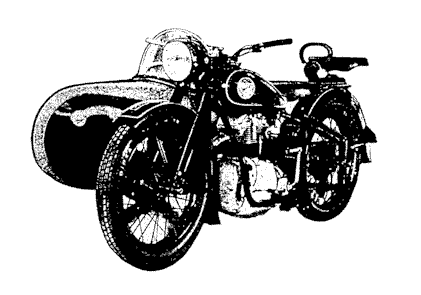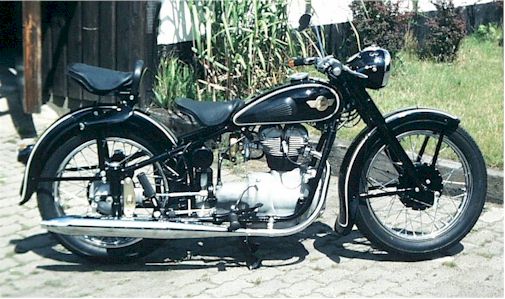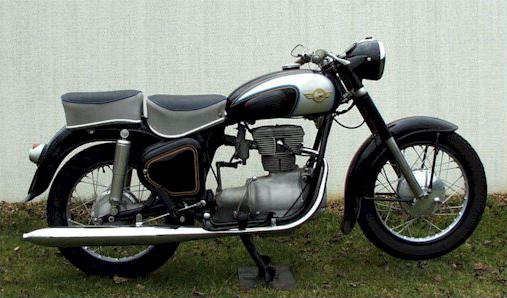| AWO-History | |
|
1856 put the brothers Simson by the purchase of iron hammer works the basic stick to an enterprise in the Thuringian Suhl, which should become already soon one of the largest rifle manufacturers. Besides one began 1896 with the production of bicycles and 1909 with automobiles. Arms production remained however the most important sector of the family business. Already soon after the choice victory of the NSDAP, the family Simson was expropriated. The national socialists made a renaming of the work in "Berlin - Suhler weapons and vehicle works GmbH" with the brand name BSW. Beside weapons, bicycles and buggies one built there from 1936 to 1941 9,000 "motorfahrraeder" with 98 cm³. 1945 were dismantled the ruestungsbetrieb by Soviet crew power and all modern buildings was blown up. But still in the same year the work resumed production of hunting rifles, bicycles and buggies as reparations. Meanwhile the enterprise under the new name "Suhler bicycle factory" had been integrated into the Soviet corporation "Awtowelo".
|
|
|
|
AWO 425-Tourenmodell
|
|
At the end of of 1948 received the Suhler enterprise from the head office of the Soviet corporations in Berlin white lake a directive for the development of a all-wheel-fitted with springs 250ccm of a cylinder four-cycle motorcycle with wave drive to the rear wheel. All detail defaults, even the output of 12 HP with 5.600/min resembled like the stroke/drilling relationship of 68 mm each those the BMW R 25, which should appear only 1950 on the market. Soon the child had also a name: AWO 425 (AWO stood for 4 for four-cycle and 25 for 250 for AWTOWELO, cm³).
|
|

|
AWO 425-Tourenmodell with Stoye I -Sidecar |
|
On 1 May 1950 the Suhler staff presented the
preproduction of 25 machines. At the end of the
crankshaft a trockenkupplung transferred the strength to
a vierganggetriebe. At the transmission exit a flexible
disk adjusted (by suspension movements of the rear wheel)
different the angle of incidence of the cardan shaft.
Until this way the technology could have come also from
BMW. But the Thuringian motorcycle farmer exceeded their
colleagues with some AWO typical details: Thus the
valves were fetched back by expensive hairpin feathers/springs
into their seat. In order to let optically smooth the
engine appear, who Celt the push rods covers in a pit on
the left side of the cylinder. A magnet supplemented the
direct current generator and ensured for the zuendfunken
meanwhile was the work no Soviet AG more, but since 1
May 1952 a state-owned enterprise ("VEB") of
the GDR. The company name should change still several
times, which lead machines however to 1957 the
designation AWO. Starting from 1957 the old name Simson
was again introduced.
|
|
|
|
Simson/AWO 425-Sportmodell
15,5 HP
|
|
The Suhler presented a more modern motorcycle, whose
building principles decreased/went back to the old AWO,
to Christmas 1955: Those popularly "sport AWO"
AWO/ mentioned Simson 425 S (= sport). The old model
remained in the program and received in favor of better
distinction the designation AWO 425 T (= routes). Within
the new double tube framework complemented each other a
hydraulically absorbed telegabel with 150 mm spring
travel and a rear wheel rocker with hydraulically
absorbed shock struts and 100 mm spring travel to
exzellentem travelling comfort. The wheels had 18 tariff
diameter and possessed light alloy full hub brakes with
180 mm in diameter. The tank seized 16 l fuel,
electrical system and the transmission was unchanged,
while one let some improvements angedeihen the engine:
The rocker arms were no longer needle-stored and the
inlet channel were so strongly broken and drilled out.
These changes brought 25 mm of carburetors and a
compression of 7,2 14 HP to that in connection with a
sucking in box, with 6.300/min. The machine was thereby
world-wide one the most attractive 250er and with
considered model care exactly like the "T"-model
up to the produktionseinstellung at the end of of 1961
was built. Capacity problems forced according to 124.000
t and 84,600 s-models for adjustment the building of
motorcycles in Suhl. From now on hunting weapons and
capacity-small Zweitakter were only built there.
by Andy Schwietzer |
|

